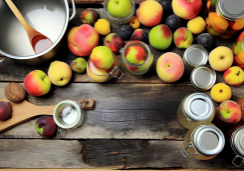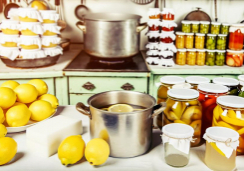Why Use Steam When Baking Bread at Home?
Imagine you've just pulled a loaf of bread from your oven, the crust perfectly golden and audibly crisp to the touch, while the inside boasts an open, soft texture. This isn't the result of an intricate recipe or a professional touch, but rather the simple act of introducing steam during the baking process.
You're aware that professional bakeries use steam-injected ovens to achieve that artisan quality, but at home, the reasons for and methods of steaming are often shrouded in a cloud of mystery.
As you stand there, admiring your handiwork, you may wonder how steam works its magic on dough and what techniques you could use to replicate this success with every bake.
Let's explore the transformative effect steam has on bread and the practical ways you can harness its benefits in your own kitchen, ensuring that your homemade bread is never again lackluster.
The Science of Steam
Harnessing the power of steam during baking is essential for the development of a perfectly crusty loaf. It facilitates the dough's expansion and enhances the final crust's texture and appearance.
When you're baking bread with steam, you're allowing for an ideal steam environment that's crucial during the initial stages of baking. This steamy environment ensures the bread to rise adequately before the crust begins to set.
Your steam ovens or home oven allows you to inject steam at the beginning of the baking process, which helps the dough stretch and expand, especially at the scored cuts. The amount of steam introduced is pivotal; too little and the crust sets too quickly, too much and you risk a gummy texture. The steam gelatinizes the surface starches of the dough, leading to a shinier crust with superior browning qualities.
However, the timing for introducing steam is just as critical. It's vital during the oven-spring phase, when yeast is most active before it has died from the heat. As baking progresses, the steam must be vented to allow the crust to become the perfect crust—crunchy and satisfyingly crusty, not rubbery.
Steam, therefore, isn't just a component but a dynamic variable in the art and science of baking exceptional bread.
Equipment for Home Steaming
Selecting the right equipment for home steaming can significantly enhance your bread's crust and overall quality. As a home baker, you have several options to create the ideal steamy environment within your home oven.
A preheated Dutch oven or combo cooker is highly effective, trapping steam naturally released from the dough. This method is straightforward and eliminates the need for additional tools.
If you prefer to bake on a baking stone or baking steel, consider placing a cast iron pan or a roasting pan filled with lava rocks on the oven's bottom rack. When you're ready to add steam, carefully pour hot water onto the rocks or pan, and quickly close the oven door to trap the moisture.
For safety and precision, ensure your steaming apparatus can withstand the high temperatures and splashes without damaging your oven or causing harm. Use a spray bottle for additional moisture and a large metal bowl inverted over the bread as an alternative steaming chamber.
Remember to remove steaming pans with caution and protect the oven door with a towel to prevent shattering from temperature shocks. Seek advice from seasoned bakers and resources like The Perfect Loaf for further guidance on steam generation techniques that suit your baking style.
Preparing Your Oven
Why not transform your kitchen into a baker's haven by preheating your oven with a metal pan inside, ready to generate the perfect steam for your bread? Preparing your oven is crucial to replicate the controlled environment of a professional bakery.
Start by placing the pan on the bottom rack while you preheat your oven to the hot oven temperatures necessary to bake bread.
As your oven inside reaches the target temperature, the metal pan gets hot enough to create a burst of steam when you introduce water. This steam is vital in the first minutes of baking, contributing to the full potential of your loaves of bread. It allows for maximum expansion and a beautifully developed crust.
Baking With Steam Techniques
Having prepared your oven with a preheated pan to create the ideal steamy environment, let's explore the specific techniques for baking bread with steam at home.
One effective method is employing a cast-iron Dutch oven. By preheating it within your oven, you can mimic a professional baker's combi steam oven. The enclosed space captures the bread's moisture, releasing steam, and contributing to a crispy crust, especially for sourdough bread.
For an alternative approach, arrange lava rocks in a preheated roasting or cast-iron pan. When you're ready to bake, carefully pour water over the rocks to generate steam. This method creates an intense burst of steam, akin to your oven's steam injection, fostering the Perfect Loaf with a delectable crust.
During the initial baking phase, cover your loaf with two sheets of parchment paper to retain moisture. Subsequently, remove any steaming pans to expose the bread to dry heat, which will allow the crust to harden and brown beautifully.
Benefits of Steamed Bread
Often overlooked, the introduction of steam during the baking process significantly enhances the final bread's crust and overall quality. When you're baking bread at home, using steam can transform your loaves from merely good to artisanal. Here are the key benefits of steamed bread:
- Improved Crust Quality: Steam creates a crispy and glossy crust by gelatinizing the starches on the dough's surface. This steam-induced sheen and crispness are hallmarks of professional artisan bread.
- Optimal Oven Spring: The presence of steam in the oven keeps the crust soft during the initial baking phase, allowing for maximum expansion. This results in loaves with a beautifully domed shape and an appealing open crumb.
- Enhanced Caramelization: Moisture from steam reacts with the sugars in the dough, deepening the crust's color and flavor through caramelization. This gives your bread a rich, complex taste.
- Versatile Steaming Techniques: Whether you're using a Dutch oven to trap moisture or introducing steam manually by pouring boiling water into a preheated pan, mastering oven steam techniques can significantly improve your baking results.
Frequently Asked Questions
Should You Use Steam When Baking Bread?
You should use steam to optimize crust formation, oven spring, and texture enhancement, utilizing artisan techniques that leverage baking science for moisture retention, even heat distribution, Maillard reaction, browning control, and hydration impact.
Can You Bake Bread Without Steam?
You can bake bread without steam, but you'll miss crispy outcomes, dynamic crusts, and optimal oven spring. Master moisture retention, understand yeast activation, and leverage artisan techniques for superior crumb texture in your bread experimentation.
What Does a Steam Oven Do to Bread?
A steam oven enhances crust formation and oven spring through improved heat distribution, triggering the Maillard reaction. You'll achieve superior moisture retention, gluten expansion, and hydration effect, key to artisan techniques and baking science.
Why Is Introducing Steam or Moisture Into the Oven Important When Baking Bread?
Steam ensures proper crust development, enhances the Maillard reaction, and boosts oven spring. It improves heat transfer for better moisture retention, volume increase, and gas expansion, while adding surface gloss and texture to your bread.
Conclusion
In conclusion, incorporating steam into your home bread baking transforms your loaves. It promotes rapid rise, soft crusts, and rich caramelization for a professional touch.
Mastering steaming techniques requires practice but pays off in superior texture and flavor. Whether using a preheated pan or ice cubes, embracing the science behind steam can elevate your bread baking game.
Equip your kitchen for success by understanding the importance of steam in bread baking. The results will be evident in every slice of your delectable, home-baked bread.










